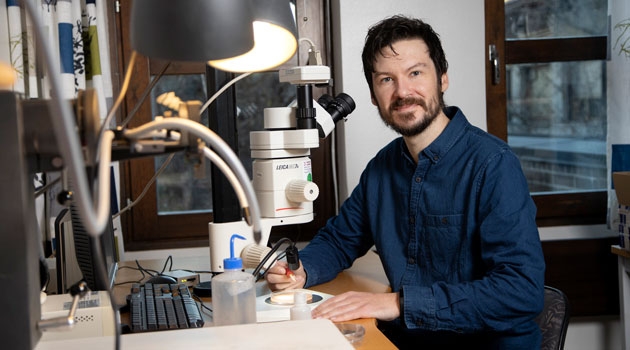Working to reveal the secrets of the earliest animals
About 580 million years ago, something happened that would change Earth forever. Complex life emerged and the first animals saw the light of day. What were these creatures? And how did they live? This is what Ben Slater, a palaeontologist at Uppsala University, wants to find out using the latest techniques.
Today, we know very little about the first animals or how they evolved. The fossil evidence is and not very easy to interpret. But in some places on Earth that have nearly 580 million-year-old rocks, there are traces from very early complex, multicell, soft tissue animals. Some resemble jellyfish or sea pens, and some are like nothing we have ever seen. These strange fossils are usually called Ediacaran biota after the geological period known as the Ediacaran Period (635–541 million years ago) during which they lived.
At this time, Earth looked much different from today. For example, the continents were concentrated south of the equator.
“It was a strange world that we would not recognize. There were no plants, so the ground was bare and very rocky. Oxygen levels were much lower than today. There was lots of life in the sea, but before animals developed there was nothing moving along the seafloor or swimming. Life was still very static,” explains Ben Slater.
Newly discovered fossils
Slater was recently awarded a grant from the Swedish Research Council to study the mysterious animal life of the Ediacaran Period. More specifically, he will study a newly discovered type of fossil, called SCF, which stands for small carbonaceous fossils.
“These are primarily small fragments of animals and other organisms, and they have not been studied previously from the Ediacaran Period.”
SCFs and are not even one millimetre large. The photo
shows these types of fossils, in this example
microscopic fragments of animals from the Cambrian
Period. Photo: Ben Slater
The SCF he will study are 580–540 million years old and from the later part of the Ediacaran Period, so from the time when the first animals evolved. The difficulty is in that the fragments are very small, not even a millimetre in size, and imbedded in rocks. To reach the actual fossils, he is utilising a new technique. In short, this involves first dissolving the rock with acid and then filtering out the organic material which is then studied under a microscope. In addition to regular microscopes, these micromillimetre fossils will also be studied using scanning electron microscopes to allow the ability to see details at the nanometre level.
Studying ecosystems
The real challenge is identifying the fragments so that in the next step they can be pieced together to create a picture of what the animal looked like. He wants to study how the Ediacaran fauna is related to younger fossils and with today’s lifeforms. These micro fossils can also provide answers to how ecosystems were structured.
“We want to find out what sort of habitat the first animals lived in. What did the ecosystem look like? For example, we also hope to find, in addition to fossils from the actual animals, remains of other organisms that made up the ecosystem: the seaweeds, algae, and bacteria that shared the animals’ environment. These will help us determine the food sources and ecology of the earliest animals,” says Slater.
Ediacaran fauna seem to disappear in the transition to the following time period, the Cambrian (541–485 million years ago), when something like a milestone in evolution occurred: the Cambrian explosion when there was a massive diversification of animals. During a relatively short period, many of the largest animal groups appeared. The common ancestors of trilobites and other arthropods, molluscs and vertebrates are just some examples of animals that developed during this period.
What happened to these animals?
“We focus on the period close to the line between Ediacaran and Cambrian. We do not know what happened to the animals from the Ediacaran Period. Maybe there was a mass extinction? Or maybe the Ediacaran fauna are the earliest ancestors to more well-known animal groups that came later,” says Slater, who is fairly sure that he will find in the Ediacaran Period some of the forerunners to the Cambrian’s animal life.
One theory for what caused the Cambrian explosion is that new predators evolved, which in turn caused the evolution of ever increasing numbers of animals equipped with hard shells and hard exoskeletons as protection from attack. Others dug into the sea floor for protection. Both survival strategies have left fossil evidence.
“I think that this is the most interesting period in the entire history of life on Earth. It constitutes an inflection point between the old microbial world during the pre-Cambrian Period and the modern, dynamic ecosystem we see today. The evolution of animals has always changed how our Earth looked, and this is where it all began.”
Åsa Malmberg

